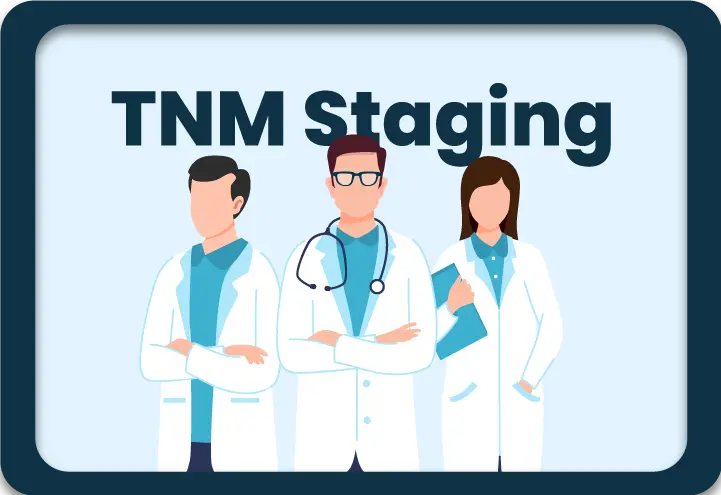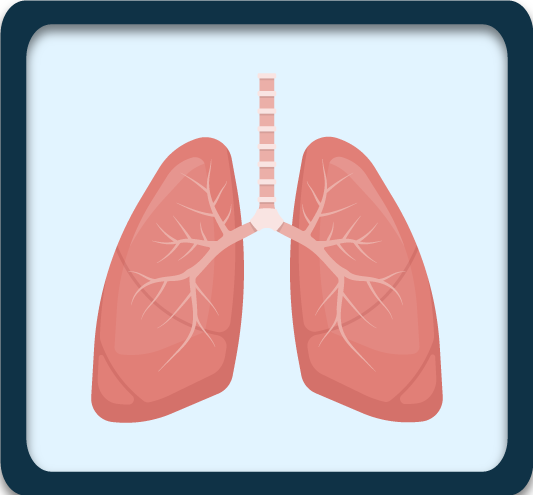TNM Staging

The AJCC TNM staging system comes from a group called the American Joint Committee on Cancer, which started in 1959. This system helps doctors describe how far cancer has spread in a person’s body.
This system was created to make it easier for doctors to talk about cancer cases, plan treatments, and do research. Over the years, it has been improved with help from many organizations and studies to make it more accurate and useful for patient care.
This system was created to make it easier for doctors to talk about cancer cases, plan treatments, and do research. Over the years, it has been improved with help from many organizations and studies to make it more accurate and useful for patient care.
T
- stands for the size and how much the main tumor has spread from where it is growing.
N
- tells whether the cancer has spread to nearby lymph nodes. These are small glands that help your body fight infection and keep it healthy.
M
- shows if the cancer has spread to other parts of the body far away from the main tumor.
TNM in Lung Cancer

In lung cancer, the TNM staging system is used to describe the extent of the disease based on three key factors:
T (Tumor): This indicates the size and extent of the primary lung tumor
N (Nodes): This shows whether the cancer has spread to nearby lymph nodes
M (Metastasis): This indicates whether the cancer has spread to distant parts of the body
T (Tumor): This indicates the size and extent of the primary lung tumor
N (Nodes): This shows whether the cancer has spread to nearby lymph nodes
M (Metastasis): This indicates whether the cancer has spread to distant parts of the body
Stages in lung cancer
1A
Stage 1A
At this stage, the cancer is confined to the lung and has not spread to the lymph nodes or other parts of the body. The tumor is relatively small, usually less than 4 cm, and the impact is localized. The cancer has not yet invaded major surrounding structures.
Stage 1A1:
The tumor is 1 cm or smaller
Stage 1A2:
The tumor is larger than 1 cm but no more than 2 cm
Stage 1A3:
The tumor is larger than 2 cm but no more than 3 cm
1B
Stage 1B
In this stage of lung cancer, the tumor is still only in the lung and hasn’t spread to other parts of the body, but it’s a bit larger—bigger than 3 cm but no more than 4 cm (about the size of a small plum).
Grown into the main airway but it hasn’t yet reached where the windpipe branches off into the left and right lungs.
Grown into the inner lining that covers the lungs, called the visceral
Caused part of the lung to collapse or led to lung inflammation by blocking one of the airways (this is called obstructive pneumonitis). This could affect part of the lung or the whole lung.
2A
Stage 2A
In this stage of lung cancer, the tumor is still in the lung and is 5 cm or smaller (around the size of a lime), but it has spread to nearby lymph nodes.
Another way to reach this stage is if one of the following things has happened:
Another way to reach this stage is if one of the following things has happened:
Grown into the main airway, but it hasn’t yet reached where the windpipe splits into the left and right lungs.
Grown into the thin inner layer covering the lungs, called the visceral pleura.
Caused part of the lung to collapse or become inflamed because it blocked an airway. This can affect part or all of the lung and is called obstructive pneumonitis.
2B
Stage 2B
In this stage of lung cancer, the tumor is still in the lung and is 5 cm or smaller (around the size of a lime), but it has spread to nearby lymph nodes.
Another way to reach this stage is if one of the following things has happened:
Another way to reach this stage is if one of the following things has happened:
The tumor is larger than 5 cm but not more than 7 cm (about the size of a small orange).
There are two or more tumors in the same section (or lobe) of the lung.
The tumor has grown into other parts around the lung, like the outer membrane covering the lungs, the chest wall, the main nerve that helps with breathing, or the outer membrane covering the heart.
3A
Stage 3A
In this stage of lung cancer, the tumor has grown and might have spread to nearby lymph nodes or other important areas. Here’s how:
The tumor is 5 cm or smaller and has spread to lymph nodes close to the windpipe on the same side of the body as the tumor, or to lymph nodes just below where the windpipe splits into two branches for each lung.
Or
The tumor is larger than 5 cm, and one of the following has happened:
The cancer has spread to lymph nodes close to the bronchi (the main airways that lead into the lungs).
The cancer has spread to lymph nodes close to the bronchi (the main airways that lead into the lungs).
- the diaphragm (a muscle that helps with breathing),
- the space between the lungs (called the mediastinum),
- the heart or large blood vessels near the heart,
- the windpipe,
- a main nerve that goes to the voice box (larynx),
- the esophagus (tube that connects the mouth to the stomach),
- a bone in the spine, or
- the area where the windpipe splits into left and right branches.
- There is one or more additional tumor(s) in the same lung.
- the space between the lungs (called the mediastinum),
- the heart or large blood vessels near the heart,
- the windpipe,
- a main nerve that goes to the voice box (larynx),
- the esophagus (tube that connects the mouth to the stomach),
- a bone in the spine, or
- the area where the windpipe splits into left and right branches.
- There is one or more additional tumor(s) in the same lung.
3B
Stage 3B
In this stage of lung cancer, the tumor has either spread to lymph nodes on the other side of the windpipe or to lymph nodes in the lower part of the neck. The tumor itself is 5 cm or smaller (around the size of a lime).
Or
The tumor is larger than 5 cm (about the size of a small orange), or there’s one or more other tumors in the same lung. In this case, the cancer has spread to lymph nodes close to the windpipe on the same side as the main tumor or to lymph nodes just below where the windpipe splits into branches for each lung.
3C
Stage 3C
In this stage of lung cancer, the tumor is more serious.
The tumor is larger than 5 cm (about the size of a small orange), or there is more than one tumor in a different section (lobe) of the lung.
The cancer has also spread to lymph nodes on the opposite side of the windpipe or lung, or to lymph nodes in the lower part of the neck.
4A
Stage 4A
In this stage, the lung cancer has spread to other parts of the body, which is called distant metastasis or metastatic non–small cell lung cancer.
Cancer has spread to the other lung.
Cancer has spread to the pleura (the lining around the lungs) or the pericardium (the lining around the heart).
Extra fluid builds up around the lungs or heart (called an effusion).
There’s one new tumor outside of the chest (like in a different part of the body).
4B
Stage 4B
In this stage of lung cancer, the cancer has spread, and there are two or more tumors growing outside of the chest area.
